Repetitive Dives
During the Table 1 lesson you learned how to determine maximum dive times and end-of-dive letter groups for your first dive.
Those processes do not apply to repetitive dives because Table 1 does not take into account the amount of residual nitrogen in your body when you begin a repetitive dive.
To determine maximum dive times and end-of-dive letter groups for repetitive dives, we use Table 3. In this lesson, you'll learn how to perform these tasks.

Repetitive Dive Terms
Before we begin using Table 3, let's cover some important terms used throughout this chapter.
- Actual Dive Time
- The duration of a dive completed, from descent until surfacing. If a safety stop is performed, that time does not need to be included in the actual dive time.
- Residual Nitrogen Time
- The amount of time you consider as having already spent at the planned depth when planning a repetitive dive. This figure is based on your residual nitrogen when beginning a repetitive dive.
- Total Nitrogen Time
- The sum of the actual dive time and residual nitrogen time. This figure is used when determining the end-of-dive letter group following a repetitive dive.
- Adjusted Maximum Dive Time
- The maximum no-decompression time limit for a repetitive dive. This figure takes into account your residual nitrogen when beginning the dive.
Table 3 Overview
Table 3 provides adjusted maximum dive times and residual nitrogen times for repetitive dives.
The letter groups on the right side are the post-surface interval letter groups from Table 2. Repetitive dive depths are located at the top of the table.
The black numbers are the residual nitrogen times for divers with a specific letter group diving to a particular depth.
The red numbers indicate adjusted maximum dive times. Notice that some cells do not contain this figure. This is because repetitive dives to a planned depth may not be possible given the diver's current letter group designation.

Adjusted Maximum Dive Time
Table 3 provides your adjusted maximum dive time for a repetitive dive based on your current letter group and the depth you plan to dive to. A higher letter group reduces your adjusted maximum dive time, and a lower letter group increases that time.
To find your adjusted maximum dive time, begin by locating your current letter group on the right side of the table. Then follow that row to the left until you reach the column for your planned depth.
The number in red is your adjusted maximum dive time. If this number is absent, a dive to that depth is not possible. You'll either have to increase your surface interval or plan a shallower dive.

For example, a dive team spent 38 minutes at 66 feet, followed by a surface interval of 1 hour and 39 minutes. Now they wish to make a dive to 52 feet. So how long can they spend at that depth?
We'll begin by determining their letter group following the first dive, which is "H."

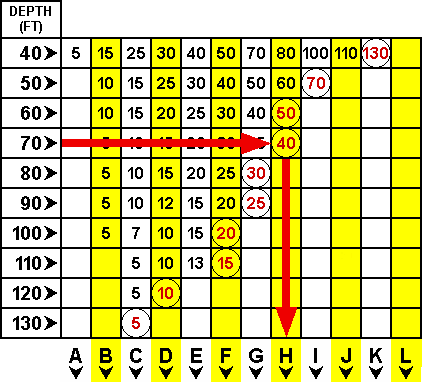
Now we go to Table 2 to determine their new letter group following the 1-hour and 39-minute surface interval, which is "F."


Finally, we go to Table 3 to determine the adjusted maximum dive time. The team's letter group going into the second dive is "F," so we follow that row.
The planned depth is 52 feet. This gets rounded up to 60 feet, so we follow the "F" row to the 60-foot column.
Now that we've found the cell for an "F" diver at a depth of 52 feet, we look at the number in red for our adjusted maximum dive time. As we can see, the team in our example can dive to 52 feet for a maximum time of 14 minutes.

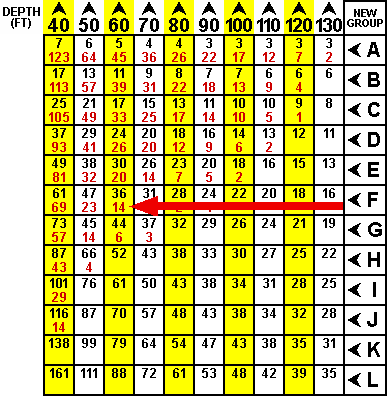
Minimum Required Surface Interval
Sometimes divers plan their surface interval time based on the minimum requirement for their planned depth and bottom time for the repetitive dive. This can be accomplished using both Tables 2 and 3.
To determine a minimum required surface interval, you first use Table 3 to determine the letter group required to dive your planned depth and time. Then you go to Table 2 to find a surface interval that takes you from your end-of-dive letter group to the required letter group for your repetitive dive.

For example, a dive team has just completed a dive and has a letter group of "D." Now they want to dive to 47 feet and have a bottom time of at least 55 minutes. So how long do they need to stay at the surface before their next dive?
We begin by locating the appropriate column for a 47-foot dive, which is the 50-foot column. Then we follow that column down until we find an adjusted maximum dive time that's at least 55 minutes long.
The first letter group that allows an adjusted maximum dive time of at least 55 minutes is "B," which allows a 57-minute dive. So the divers need to become "B" divers before beginning this dive.
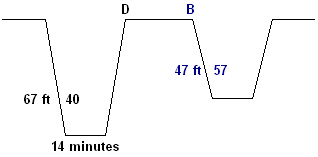

The divers had a letter group of "D" following their first dive, and we want to find the minimum surface interval required to give them a letter group designation of "B."
To determine the minimum required surface interval, find the required letter group on the left side of the table and follow that row to the right until you locate the column for the diver's end-of-dive letter group, which was "D." And we can see that the divers need a surface interval of at least 2 hours and 39 minutes to make their planned repetitive dive.
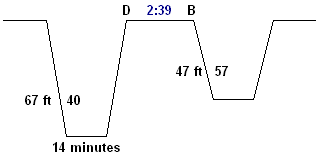

Repetitive Dive Letter Group
You may have noticed that Table 3 does not provide end-of-dive letter groups. To determine your end-of-dive letter group following a repetitive dive, you need to return to Table 1.
When determining your letter group for a repetitive dive, you need to consider the residual nitrogen from your previous dives. So instead of using your actual dive time to determine your letter group, you'll use a figure called total nitrogen time.
You calculate your total nitrogen time by adding your actual dive time to the dive's residual nitrogen time. So let's first look at how to determine your residual nitrogen time.

Residual Nitrogen Time
Residual nitrogen times are the black numbers in Table 3. This figure is based on the letter group you began the dive with and the depth you dove to.
To find your residual nitrogen time, you first locate the letter group you began the dive with on the right side of the table. Next, you follow that row to the column for the depth you dove to. The number in black is your residual nitrogen time.

For example, a diver ends a surface interval with the letter group "B," and then dives to 70 feet. To find the residual nitrogen time, we begin by locating the "B" letter group row.
Next, follow the row to the right until we reach the column for 70 feet, and we can see that the residual nitrogen time for this dive is 9 minutes.
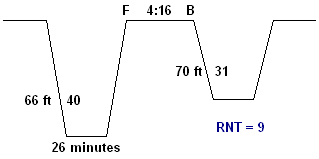

Total Nitrogen Time
After determining your residual nitrogen time, the next task is calculating your total nitrogen time. To calculate this figure, you add your residual nitrogen time to your actual dive time.
For example, a dive team with the letter group "F" dove to 32 feet for 45 minutes. First, we determine the residual nitrogen time for this dive.
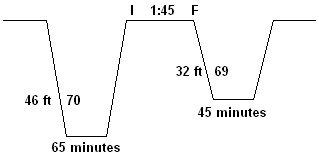
The dive team's residual nitrogen time is 61 minutes, so we add that to their actual dive time of 45 minutes to get the total nitrogen time, which is 106 minutes.


Calculating Repetive Dive Letter Groups
Now that you know how to calculate total nitrogen times, you're ready to determine letter groups following a repetitive dive.
To find your letter group you return to Table 1, since this is the only table that provides end-of-dive letter groups. But instead of using your actual dive time, you use your total nitrogen time. Let's look at an example.

A diver with the letter group "B" has just completed a dive to 56 feet for 20 minutes. So let's begin by calculating the total nitrogen time.
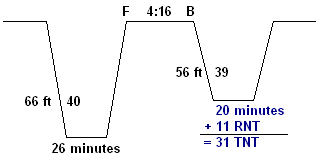
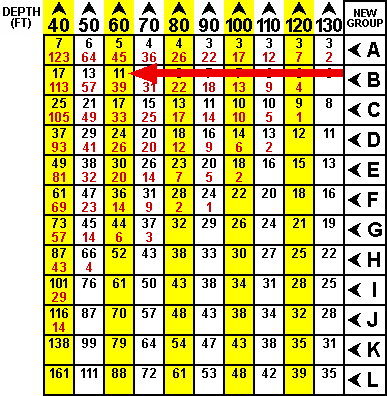
Now you return to Table 1. The dive was to 56 feet, so we'll use the 60-foot row. Follow the 60-foot row to the right until you see the dive time that's as large or equal to the total nitrogen time of 31, which is the 40-minute cell.


Finally, you follow the column straight down to the end-of-dive letter group, which in our example is "G."

